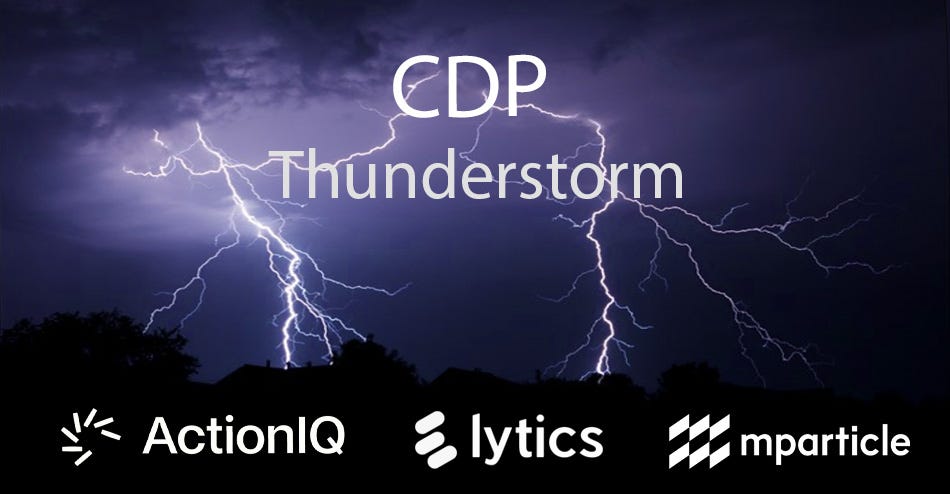CDPs: The Beginning of the End?
2024 marked a milestone that Customer Data Platform (CDP) vendors had been waiting for—their moment in the spotlight. With the release of Gartner’s first Magic Quadrant for CDPs and Forrester’s B2C CDP Wave, the category finally earned some recognition.
Yet, my thunderstorm warnings surrounding the CDP market appeared to be proven accurate.
By now, you’ve probably heard the major M&A news from the U.S. CDP space:
In this post, I’ll explore how we got here and, more importantly, what these shifts mean for organizations—whether you’re a CDP user, owner or just watching from the sidelines.
Customer Data Platforms: No Longer Living Up to Their Name
The most commonly cited definition of a CDP comes from the CDP Institute:
packaged software that creates a persistent, unified customer database that is accessible to other systems.
While this definition has served as a guiding principle, the reality has shifted. Legacy databases, once incapable of scaling to the needs of marketing workloads on customer data, are no longer the standard. Enter the Cloud Data Warehouse, which feels like a more natural fit for the original CDP concept (minus the packaged software part).
The rise of composable CDPs signaled an important acknowledgment: when possible, data should remain in its system of record—the source of truth. And that source of truth? It wasn’t really supposed to be the CDP itself.
What’s Left for CDPs?
If CDPs are no longer the go-to solution for creating a unified customer database, what role do they play today? CDPs primarily serve as an audience segmentation layer.
Legacy Customer Engagement Platforms (CEPs) and Marketing Automation Platforms (MAPs) weren’t built to scale, creating the opportunity for an intermediary layer—taken by the CDP—to bridge customer data with customer experience delivery.
Fast-forward to today, and CDPs are sticking to their role as audience segmentation hubs. The natural (or perhaps only) progression from there has been to build orchestration capabilities. While this makes sense in theory, it’s a tricky move in practice. Orchestration encroaches on an already crowded space dominated by CEPs—ironically, the very platforms CDPs often integrate with as activation partners.
In December, I wrote about how these evolutions are reshaping tech stacks, often leading to two configurations:
[CDP = Audience Segmentation + Orchestration] | [MAP = Delivery]
[CDP = Audience Segmentation] | [MAP = Orchestration + Delivery]
I still believe the CDP and CEP categories are on a path to convergence. Companies like ActionIQ, Twilio, and Treasure Data have already developed orchestration layers on their CDPs.
But two other paths are emerging:
Mergers and Acquisitions: Recent examples include ActionIQ, Lytics, and mParticle exiting the market via acquisitions.
Rebranding or Stepping Away from “CDP”: It’s funny how everyone once rushed to label themselves as a CDP, only to now reconsider. Amperity and Census, for example, recently removed "CDP" or "Composable CDP" from their websites.
What Does This Mean for Enterprise Organizations?
Or, put simply: how much should you care about all this?
The danger for enterprises when choosing software is focusing too much on the category label rather than the problem they are trying to solve. It’s counterintuitive but surprisingly common.
TMW’s newsletter from Keanu summed it up perfectly this week:
"During my consulting days, if a client told me that they thought they needed a CDP, my first step would always be to decompose the capabilities, strip away the acronyms, and focus on which parts were needed for the objectives and use cases they had in mind. Regardless of whether CDPs are being unbundled or re-bundled, that approach is as valid today as it was back then." — Keanu Taylor
🔑 The question isn’t really "CDP or no CDP?" Every organization will always need tools to store customer data, build audiences, orchestrate experiences, and deliver those experiences to consumers. The technology stack will continue to include one—or several—solutions, each likely earning its own three-letter nickname.
And the evolution doesn’t stop here. Generative AI is reshaping how these use cases are addressed, introducing new interfaces and, quite possibly, sparking a wave of fresh three-letter acronyms for emerging martech.
Disclosure: I am a former ActionIQ employee. As with all Foreign Key published content, the opinions shared here are my own.



